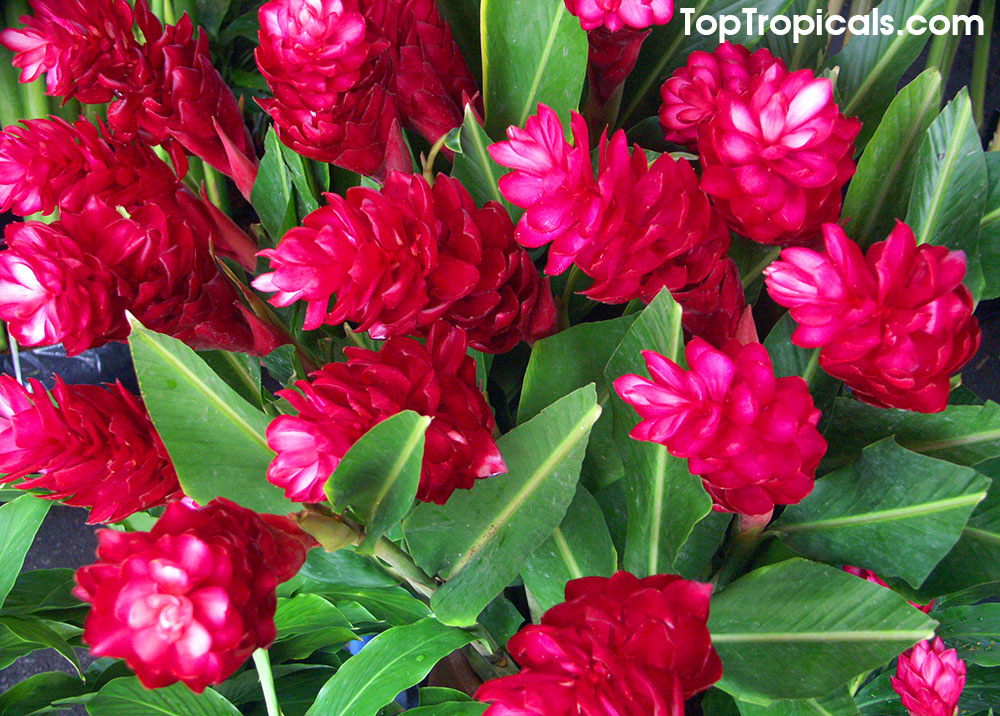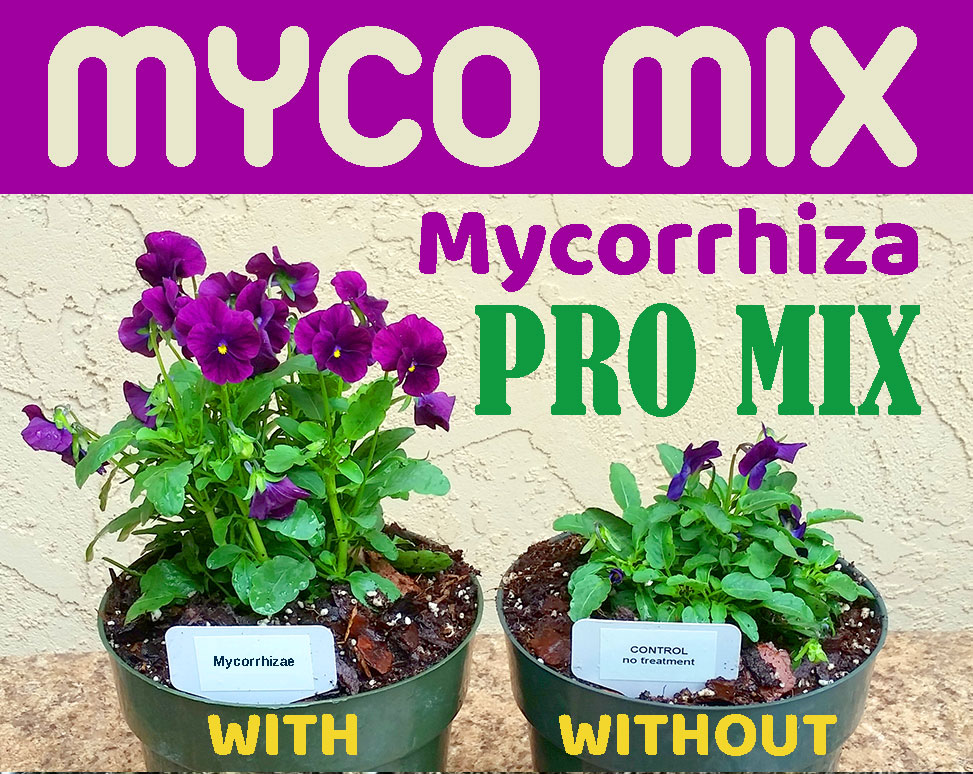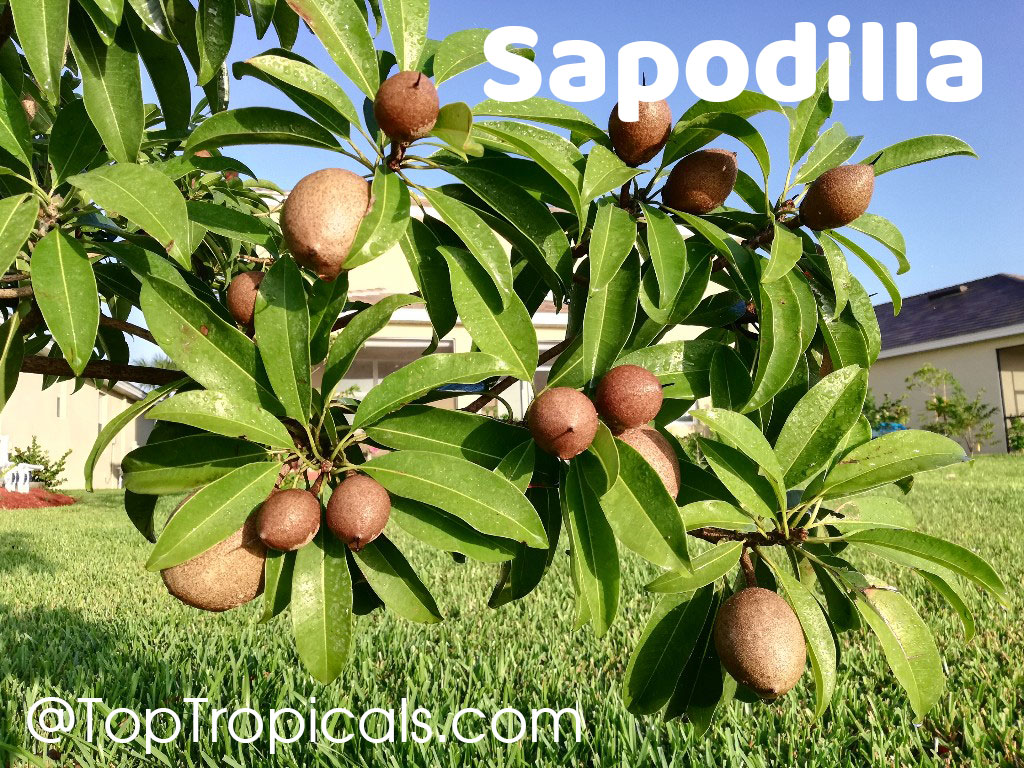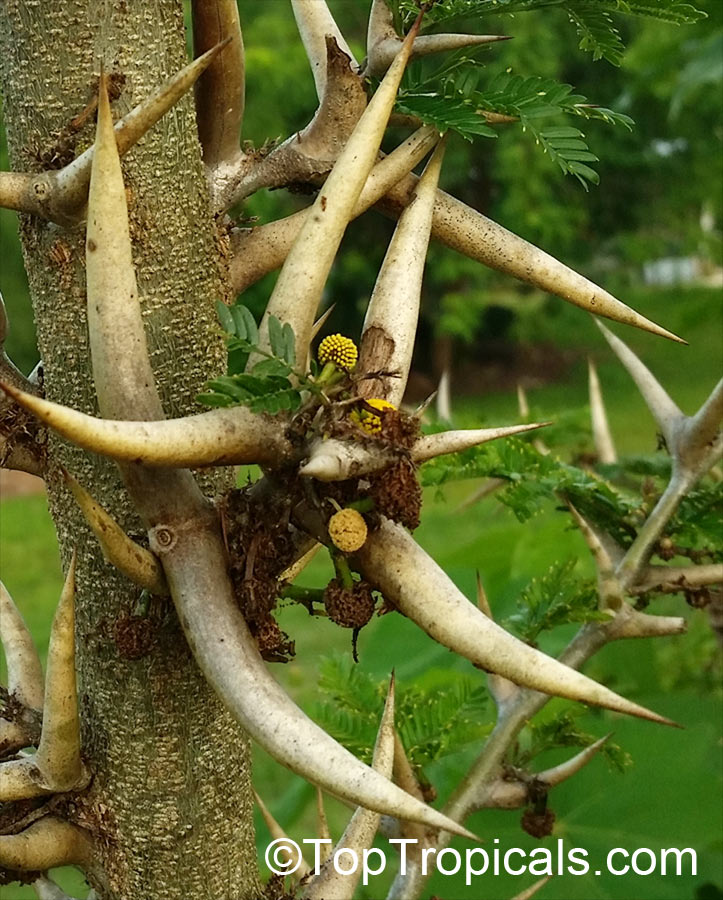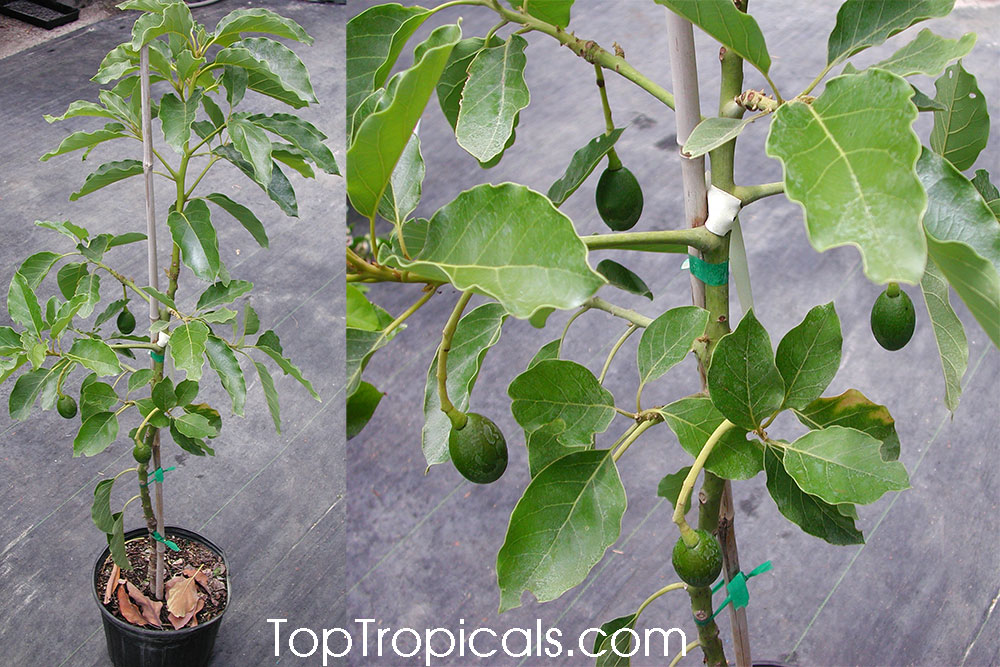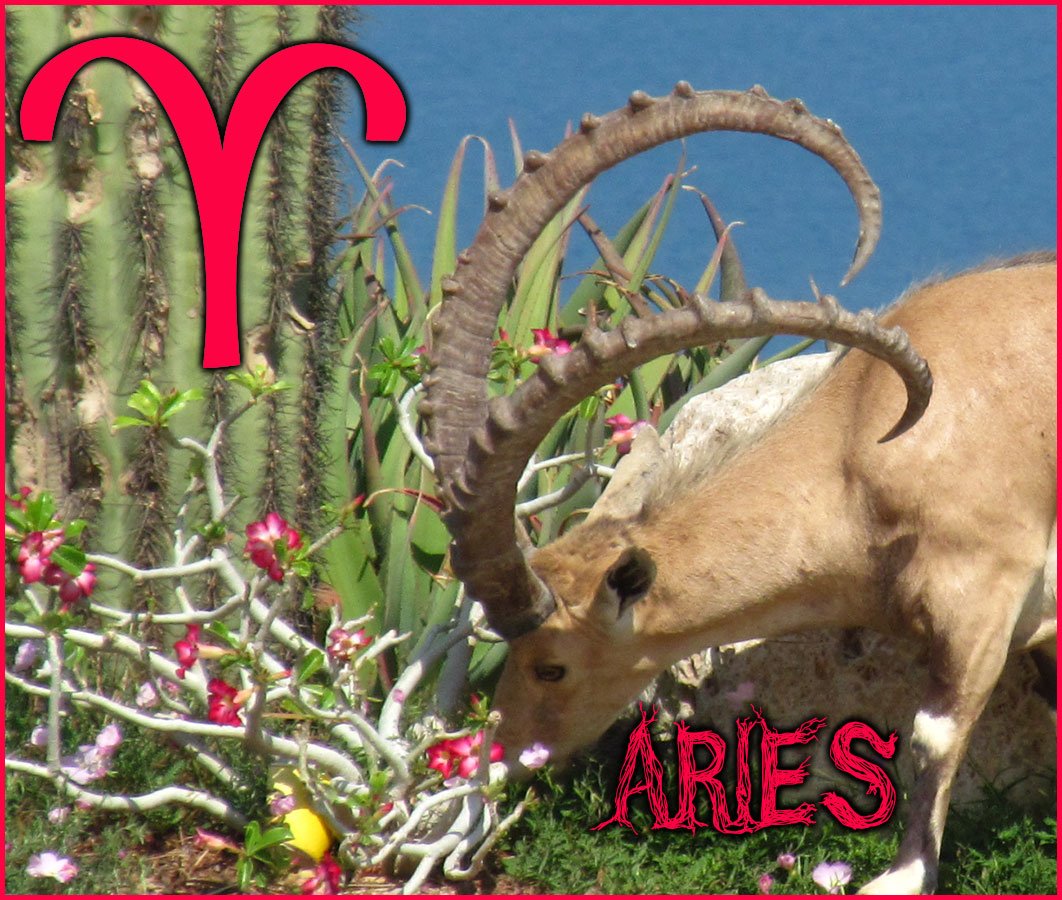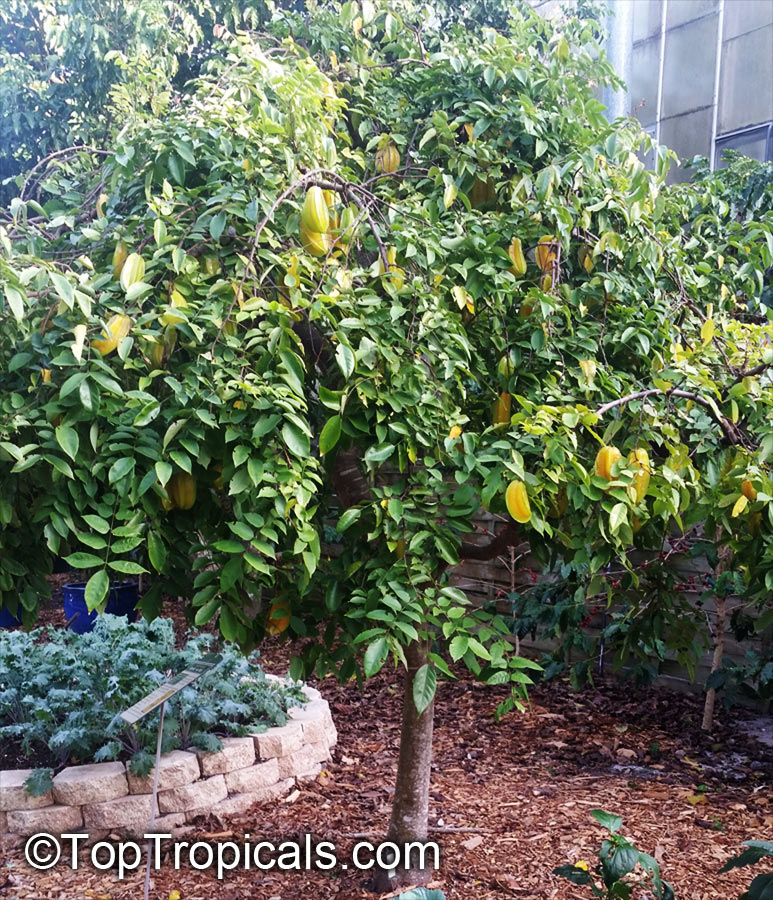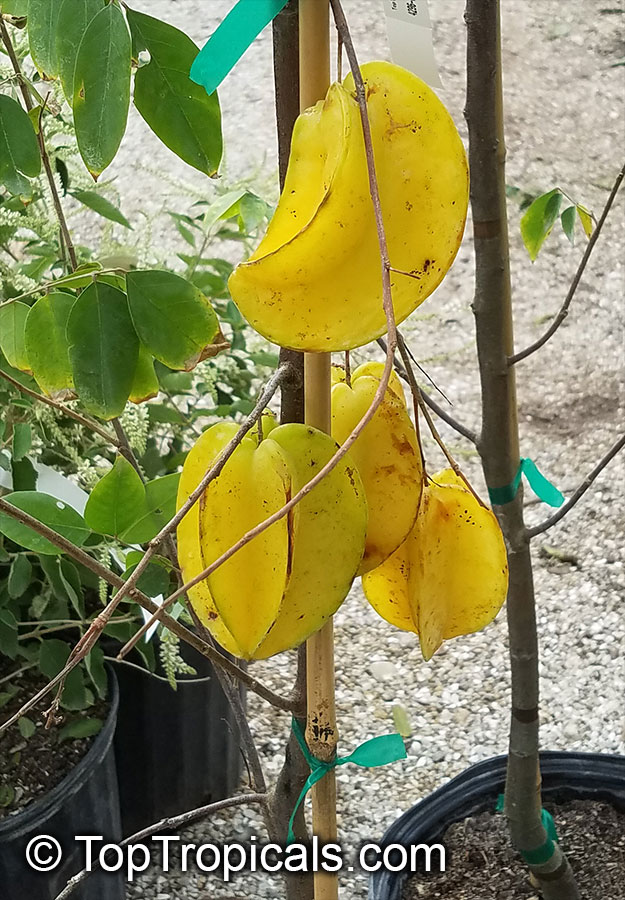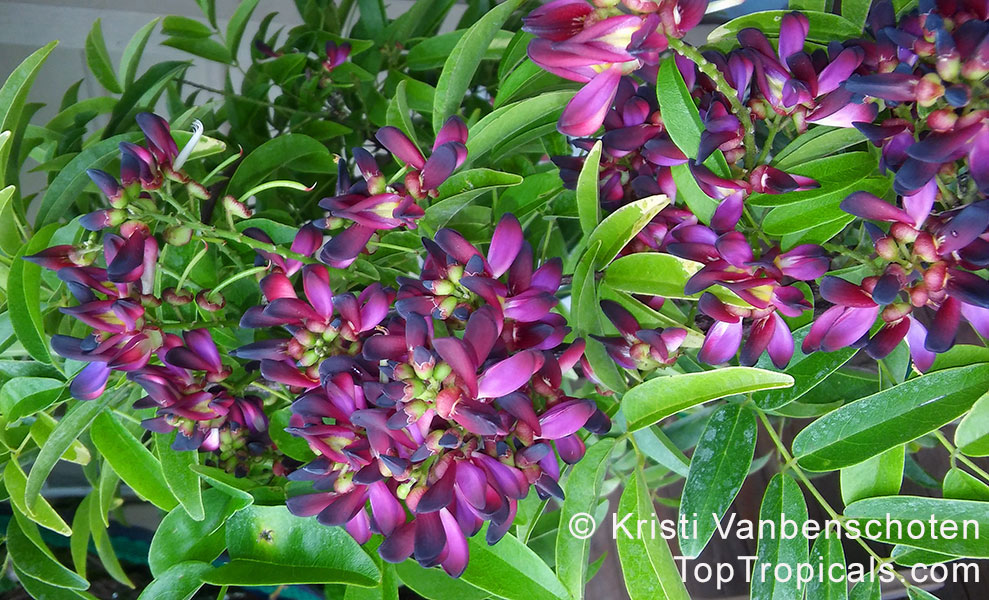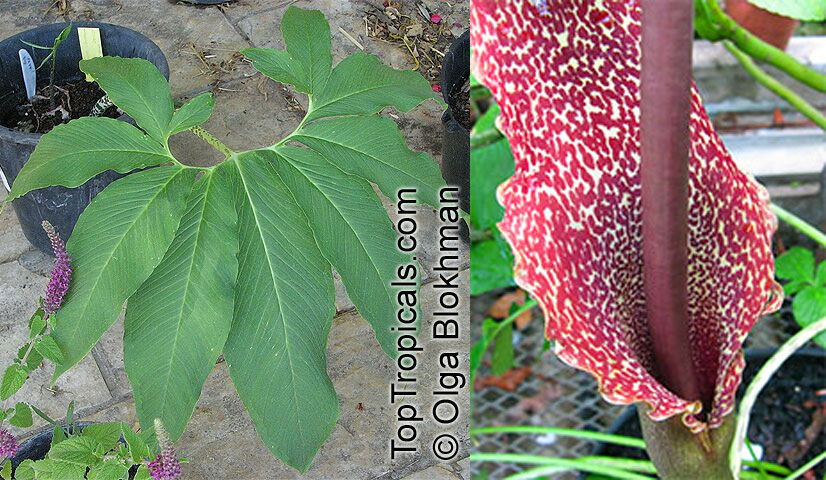Garden Blog - Top Tropicals
Date:
Dwarf Red Ginger - more than just a pretty face
Q: I've just recently moved to Florida from North Carolina. I don't know much about tropical plants. Can you perhaps suggest an easy and pretty flowering plant for a beginner which I can plant around my garden pond for a tropical feeling?
A: For adding that tropical look to your garden, few plants beat
beautiful ginger! Alpinia purpurata, the Dwarf Red Cone Ginger with its bright red floral
spikes and lush, lance-shaped foliage is no exception. This striking
perennial will add a tropical effect to your garden that will definitely take your
breath away.
The Dwarf Red Cone grows between 3 and 4 feet tall and blooms 8-9
months of the year! The blooms will hold on the plant for up to 3 weeks! It makes
a very attractive and distinctive backdrop for other plants.
Red Cone Ginger likes partial shade and moist, humid conditions, but
will tolerate full sun. It is fast growing, easy to grow and resistant to
disease, heat, and insects. The plant is a wonderful accent in a garden and works
well as a focal point specimen, show-stopping when planted around garden
ponds or near entryways. This ginger also works very well in containers and
planters. Either in mass plantings or smaller groups, all gingers add tropical flair which never disappoints.
In addition, the beautiful flower spikes make for great, long-lasting
cut flowers and is an interesting addition to bouquets.
An added bonus? Dwarf Red Ginger is super easy to propagate. If stems
are cut at the base and placed in water, they will generally root within a few
weeks. Eventually, you can make a whole flowering hedge just from one
plant!
Who does not like a plant that is non-fussy and not only beautiful but easy to grow? Dwarf Red Ginger is more than just a pretty face!
To keep this plant happy and blooming, give it some food: Broad Leaf Plus - Ginger-Heliconia-Banana Booster.
Date:
Magic mix for stubborn plants
Myco Mix - magic mix with Mycorrhiza
 A word from the owner...
A word from the owner...
...When I first started growing tropical fruit trees, I noticed that
Lychee just can't be grown from seed, period. The seed germinates readily, a
little happy seedling grows like crazy... but only for the first couple weeks.
Then it stops. Then it shrinks. Then it dies.
My teacher, tropical fruit tree expert Murray Corman (Garden of Delights), made fun of me for growing Lychee
from seed, and explained his sarcasm with two words - "Need Mycorrhiza!" It
appears that in Nature, Lychee seedlings can only grow around its mother plant
which has this magic plant-friendly fungus around its roots! The only way to
succeed with some seedlings is using this amazing Nature symbiosis... Check
out Mycorrhiza - and try it, works 100% in all stubborn cases!
Myco Mix is an amazing underground secret to a better garden! This professional growing medium with Mycorrhiza is a must for establishing plants, recovering weak plants, and for transplanting applications, including seedlings and cuttings...Learn more...
Date:
Growing sapodilla in container and indoors
Q: I live in northwestern Washington state. I was wondering if I can grow a Sapodilla tree indoors in a container? Are they self-fertile, and which variety do you think would do best in a large container?
A: A: All Sapodillas are self-fertile. They can be successfully
grown in pots due to their slow growth rate and compact nature. The most
important requirement for successful growing and fruiting is a bright light, other
than that it is a very undemanding plant and is not fussy about watering.
The best variety for potting culture is Silas Woods which is a dwarf kind. This variety is the most profuse
producer, flowering and fruiting nearly year round providing bright light and
warmth. Although the fruit are smaller than other varieties and average 3-4"
size.
Sapodillas require regular fertilizer applications for good production.
We recommend Fruit Festival slow release fertilizer for the best results.
Date:
Featured plant. Acacia sphaerocephala - Bulls-Horn Acacia
Acacia (Vachellia) sphaerocephala - Bulls-Horn
The name of this cool unusual tree comes from the shape of the thorns which do indeed resemble the horns of a bull! The tree has a strong, symbiotic relationship with a species of an ant, Pseudomyrmex sphaerocephala for which it is the obligate habitat. The ants act as caretakers for the tree, and clear the ground and keep it free of any other plants and even prune surrounding branches of other trees that threaten to outshade the acacia. Without the protection of the ant colony, the acacia tree would fall vulnerable to chewing insects such as beetles or caterpillars, and surrounding trees and shrubs would quickly outcompete the acacia without the maintenance work of the ants to keep the tree safe.
Date:
Clay or plastic?
Q: I purchased an Avocado tree and planted it in a nice clay pot that I bought in a special pottery place. My tree looked very healthy when arrived but after a week leaves become droopy and started yellowing. I was advised this was a sign of over-watering. I watered the tree only once since I got it 2 weeks ago. What is wrong with my plant?
A: Unfortunately, the fancy pot may be the reason. Although clay pots (plain clay, without glaze) are considered to be good for root health, however, the root system is hard to control and difficult to check without disturbing. Clay pots with fancy glaze and painting may have a drainage problem. We have noticed that cone-shaped pots are usually problematic for drainage, and a plant always has "wet feet". Avocados like watering, but cannot tolerate sitting in water. If you want to avoid root problems and still like to keep a beautiful look of your treasure plant, you may use a fancy planter, where you can put your plant growing in a plain plastic black nursery pot of much smaller size than a planter: its vertical walls are perfect for drainage, and the pot is easy to remove for re-potting or inspecting. Make sure to put a layer of drainage rock on the bottom of the planter so your efforts won't be in vain.
Date:
Aries - 3/21-4/19
 Aries is a FIRE sign ruled by the planet Mars. Plants associated with
this element and planet very often have thorns or prickles. They can be also
spicy or bitter in flavor, or red in color. Because Aries rules the head,
eyes, and face, the plants for Aries purify the blood, stimulate the adrenal
glands, and/or are high in iron (Mars rules the mineral iron). Mars-ruled Aries
is assertive, energetic and fearless. Mars rules the red blood cells, the
muscles, and metabolic processes, as well as the motor nerves and the head. These
plants help you when you want more get-up-and-go and the courage to take on
the world.
Aries is a FIRE sign ruled by the planet Mars. Plants associated with
this element and planet very often have thorns or prickles. They can be also
spicy or bitter in flavor, or red in color. Because Aries rules the head,
eyes, and face, the plants for Aries purify the blood, stimulate the adrenal
glands, and/or are high in iron (Mars rules the mineral iron). Mars-ruled Aries
is assertive, energetic and fearless. Mars rules the red blood cells, the
muscles, and metabolic processes, as well as the motor nerves and the head. These
plants help you when you want more get-up-and-go and the courage to take on
the world.
Aries Zodiac lucky plants:
Governors plum, Hibiscus Karkade, Tapioca, Mamey Sapote, Ruda, Baobab, Euphorbia, Acanthus, Aloe, Caesalpinia, Erythrina, Opuntia, Dragon Fruit, Pachypodium, Pomegranate,Chilli peppers, Syngonium, Begonia, Geranium, Red Sandalwood, Jamiaca pepper (Pimenta, Allspice), Camphor, Jujube, Anise, Red Roses, Tiger Lily, Impatiens, Calendula, Tarragon, Ginger, Coriander, Basil,Ruda, Amaryllis, Wild Indigo, Gooseberries, Sesbania, Campsis, Red Oleander, Maple, Schotia brachypetala, Momordica, Coffee, Amla , Ephedra, Red Kapok.
For links to these plants and other signs information, see full Plant Horoscope.
Date:
Hawaiian Dwarf is a True Star!
By Mark Hooten, the Garden Doc
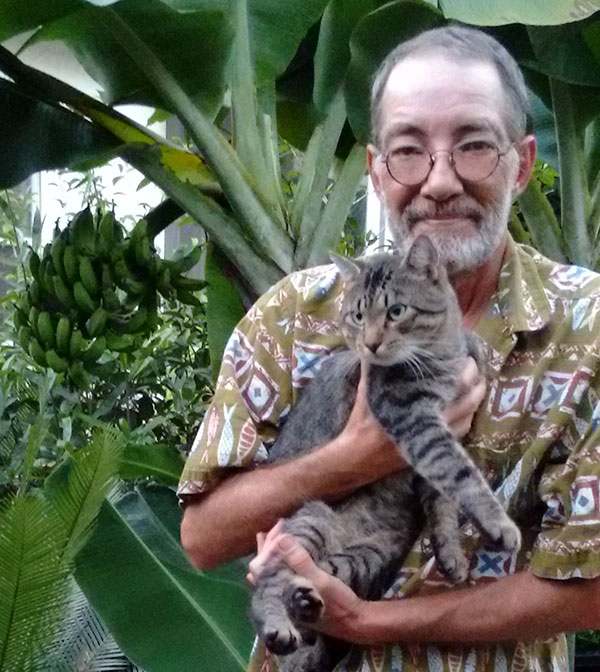 Q: I live in Southern Ohio and love growing lots of tropical plants.
In the warm months, they all go outside under the protection of tall trees,
but in the cold months, they all come inside in a snug but very brightly lit
sun-room. For many years I have successfully kept a dwarf Meyer's lemon which
amazes my friends, and I am wondering if you could suggest some other dwarf
tropical fruit tree which I might be able to grow that would amaze them even
more?
Q: I live in Southern Ohio and love growing lots of tropical plants.
In the warm months, they all go outside under the protection of tall trees,
but in the cold months, they all come inside in a snug but very brightly lit
sun-room. For many years I have successfully kept a dwarf Meyer's lemon which
amazes my friends, and I am wondering if you could suggest some other dwarf
tropical fruit tree which I might be able to grow that would amaze them even
more?
A: Without hesitation, I would strongly suggest a particular variety of carambola (star-fruit) called Dwarf Hawaiian, as it is truly special as tropical fruit trees go. First and foremost, they begin fruiting at a very young age, often while only in a one-gallon pot, and even less than a couple of feet tall with a very little trimming. Better even is that they are perfectly happy living perpetually in a pot. I have one myself which is content in a 12 inch pot and which fruits freely throughout the year. Also, even though it should be too much to be expected, the fruits are of the highest quality and are as sweet as candy. I also like the fact that the fruits hang decoratively on the tiny tree for quite some time before finally ripening, rather like ornaments. One of these little trees in-fruit is an amazing sight and ought to make anyone take notice, especially in a sun-room in Ohio! They really are very easy to grow, and if you have a Meyer's lemon which does well, you'll certainly have no particular issues with a Dwarf Hawaiian carambola.
However, I have found that in order for them to remain extra dwarf and fruit especially precociously, this variety needs to be grafted and not cutting grown. Fortunately, Top Tropicals has recently obtained a number of these extra wonderful grafted trees which are of the highest quality I have seen in some time, all of which will likely begin fruiting very shortly. They simply are wonderful little trees! Check them out...
Date:
Featured plant. Heliconia rostrata - Lobster Claw
Heliconia rostrata - Lobster Claw
Lobster Claw, Parrot's beak... Tropical flowers never fail to astound and amaze with their forms and colors. Lobster Claw plant (Heliconia rostrata) is no exception, with large, brightly hued bracts that cluster up a stem. It is also called Parrot Beak and has inconsequential tiny flowers covered by the showy bracts. It is native to Central to South America and is one of the most recognized and widely grown species of showy heliconias, and one of the most beautiful! The inflorescence it produces is one of the most colorful you will ever encounter. Pendulous blooms of striking red and yellow bracts often reach 3' in length! The flowers last a long time and make an excellent cut flower. It is an easy grower in tropical areas but some room is required because the stalks can reach 7 feet in height. It can withstand temperatures in the high 20s. Can be grown in large pots, it starts blooming once the plant reaches 4-5' tall and the amazing inflorescences will appear one after another creating a spectacular show to enjoy. Grow in full to partial sun and rich soil with lots of water and fertilizer.
Date:
Spectacular Evergreen Wisteria
Q: When I was a child growing up in Virginia, my mother always had Wisteria growing around the house. It became one of my favorite plants growing up. I loved the beautiful cascading purple flowers. The highly fragrant and colorful flowers provided a feast for the senses. I have now re-located to Florida and understand the the Wisteria I knew as a child will not flower here in the warmer climate. Is there a vine similar to the wisteria that I can grow here in Florida?
A: There is a great alternative to the Wisteria sinensis you knew and loved as a child! Millettia reticulata - Evergreen Wisteria is a beautiful and highly fragrant vine. Unlike Wisteria sinensis, Millettia is not an invasive plant and can be maintained much more easily. The royal purple flowers completely cover the plant throughout the Spring and Summer.
Date:
Featured plant. Sauromatum (Typhonium) venosum - Voodoo Lily
Sauromatum (Typhonium) venosum - Voodoo Lily
Rare Amorphophallus ralative, Typhonium venosum (Sauromatum venosum), is
a common shade-loving house or garden plant from temperate and tropical
Africa and Asia. This plant is also known as the Voodoo Bulb because of its
ability to flower from a corm without soil and water. Tuberous perennial with
solitary, segmented round leaf and strange, arum-like flower. Rare collectable,
it is a showy exotic container plant.
Typhonium grows to around 20 inches tall from an underground corm. A
large corm can spawn multiple new corms. Inflorescences emerge before the
leaves. An inflorescence has a purplish-brown-spotted, yellowish spathe and a
purplish-brown spadix which emit a strong odor perceived as similar to cow
manure, rotting flesh, or a dirty wet dog, depending on who smells the
inflorescence ;) The odor lasts only a day and attracts carrion-feeding insects which can
pollinate this plant.
Plants we have in stock, have tubers 1-2" in diameter. The plant goes
dormant in winter and starts sprouting in March-April. Keep soil slightly
moist but not wet, and wait for the magic leaf to pop up... The plant should
flower within a year or two.
